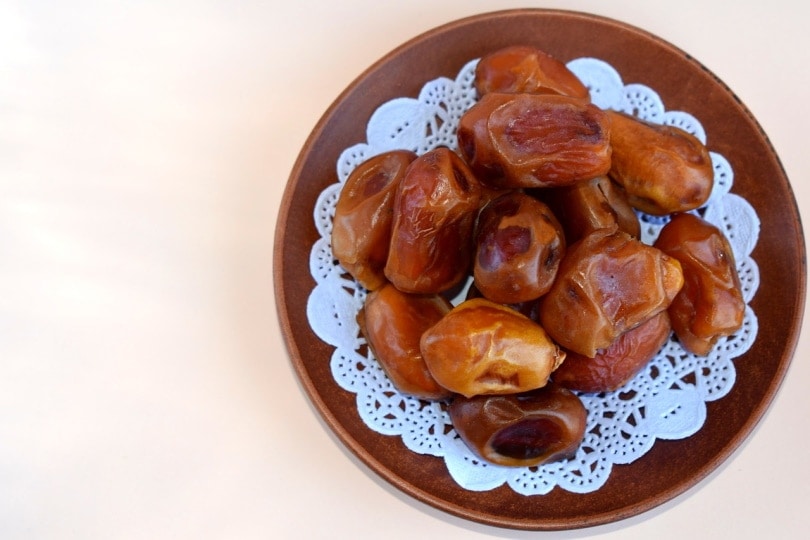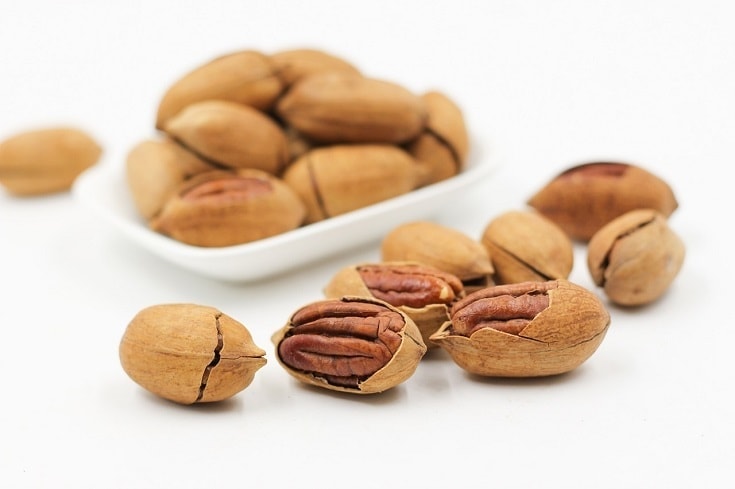Cockatiel vs Lovebird: Key Differences (With Pictures)

Updated on
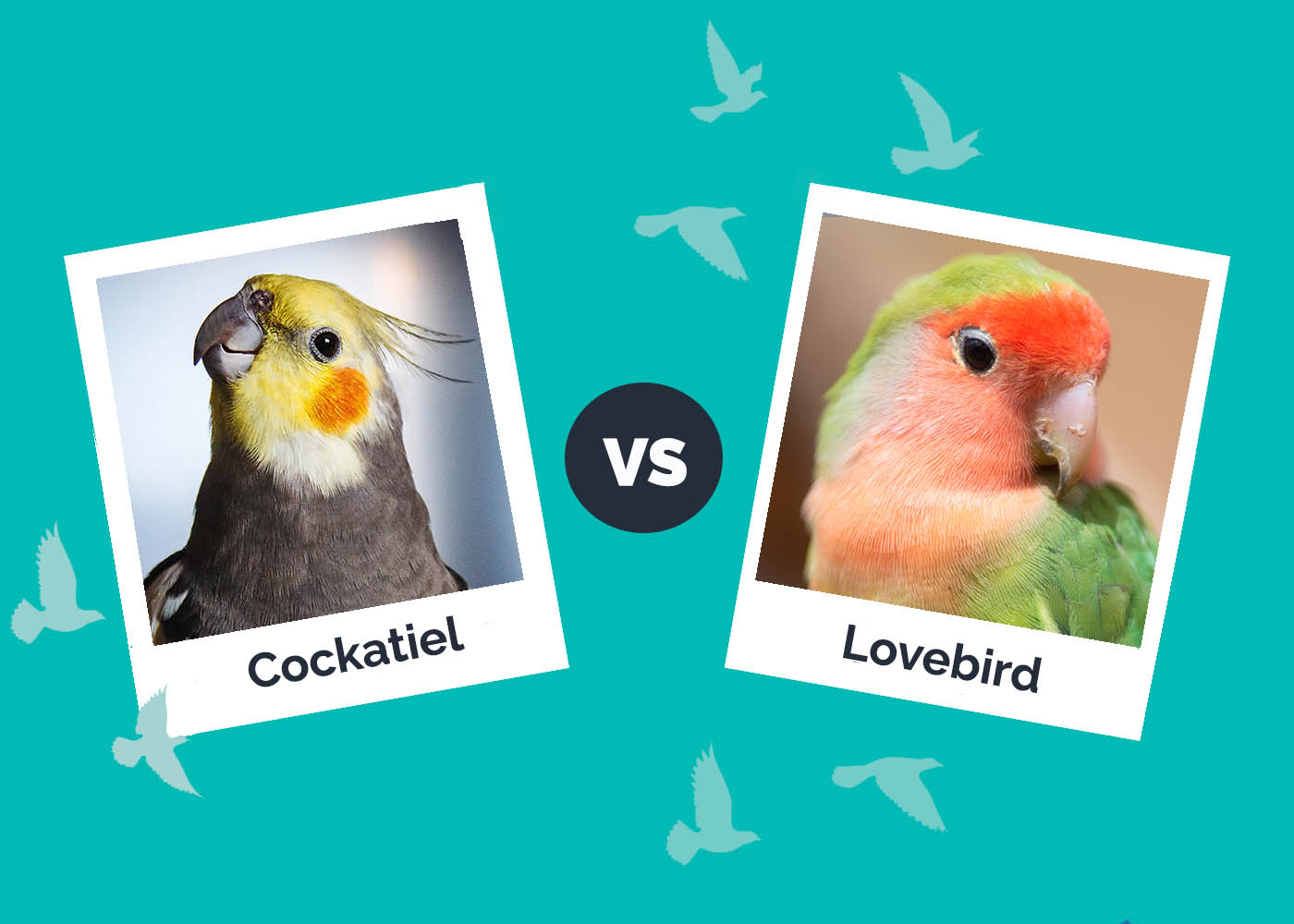
Cockatiels and Lovebirds are two of the more popular species of birds that are kept as pets around the world. They are popular because they are smaller than large parrots, pretty to look at, and exhibit fun and exciting habits and tendencies that make them exciting housemates. While they are similar in that they are both common pet birds, there are several differences between the two species.
The Cockatiel is known for its gray and yellow coloring, while the Lovebird comes in a dazzling array of yellows, oranges, reds, and greens, and there are also blue varieties. In terms of temperament, the Cockatiel is a more laid-back and docile bird than the Lovebird, which not only means that it is more likely to tolerate being handled but it is better for a mixed aviary with other bird species.
Below, we look at these different species in greater depth and compare their differences to help determine which might make the best breed for you.
Visual Differences
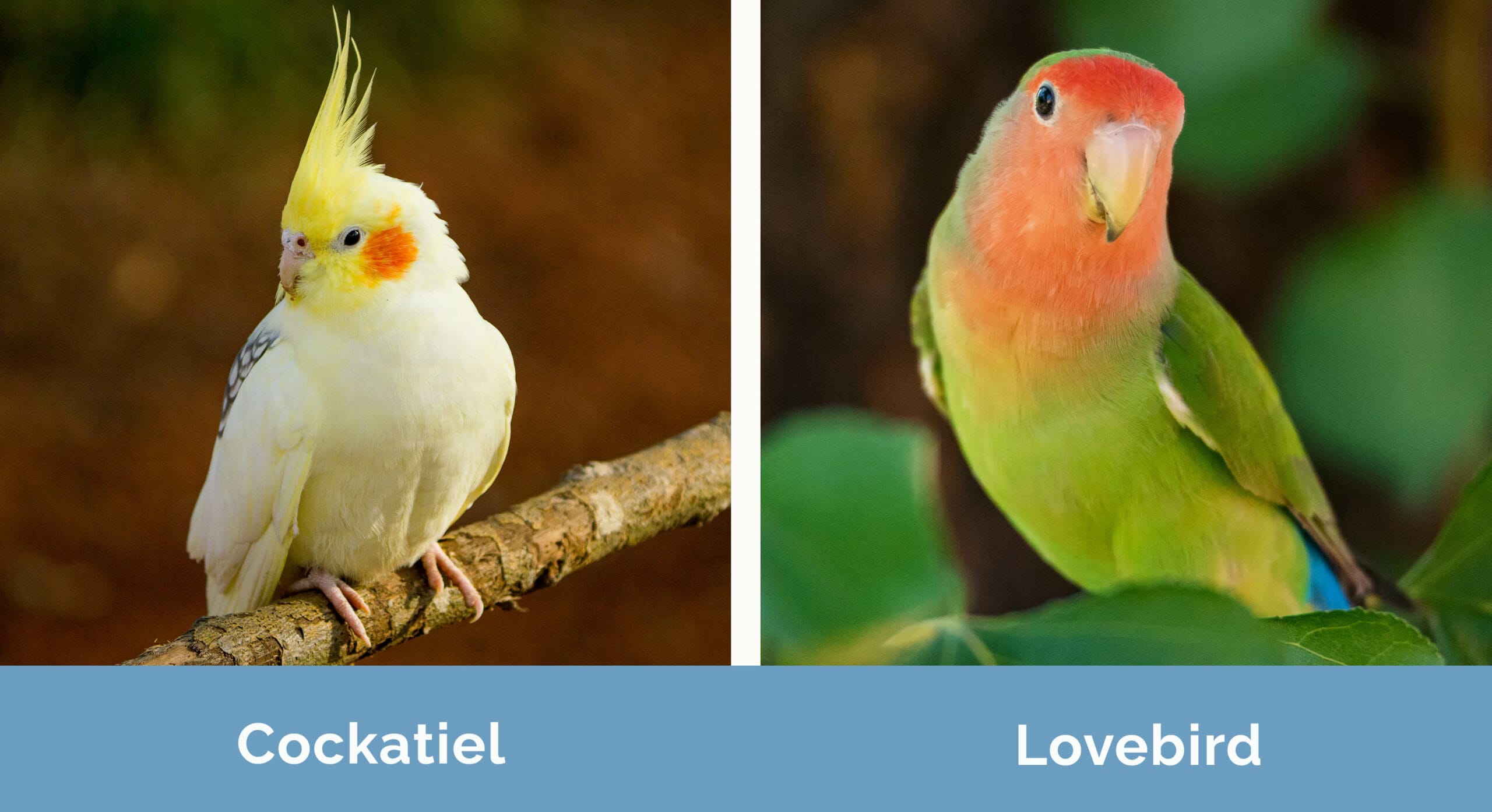
At a Glance
- Average height (adult): 12–13 inches
- Average weight (adult): 2–4 ounces pounds
- Lifespan: 10–15 years
- Grooming needs: Easy
- Other bird-friendly: Yes
- Trainability: Males can be taught to whistle, both genders can be taught some commands
- Average height (adult): 5–7 inches
- Average weight (adult): 1.5–2.5 ounces
- Lifespan: 15–25 years
- Grooming needs: Easy
- Other bird-friendly: Can attack more docile birds
- Trainability: Intelligent and quite easy to train
Cockatiel Overview
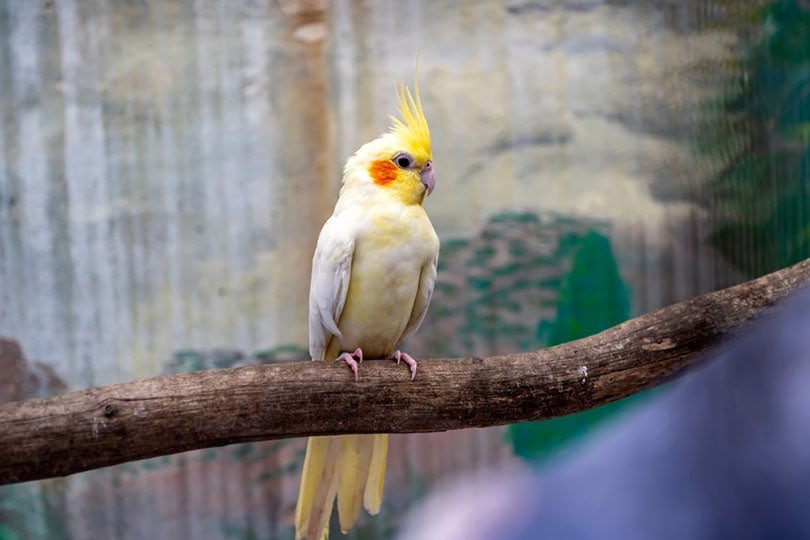
The Cockatiel is a medium-sized parrot that originates from Australia where they live in open environments and forage food on the ground. Because they are smaller than large parrot breeds, can tolerate handling, and are relatively docile birds that will even get along with other bird species, they have become popular pets throughout the world. They are small enough to handle and tame enough to be interesting and some can learn a few words, all of which adds up to them being considered an excellent starter bird.
Personality / Character
Cockatiels are very popular pets. They are small enough to be easy to house but large and amiable enough that they can be handled. They are bright and lively little birds but are also quite sensible and not as twitchy or nervous as some other species. They can get along with other bird species because they are considered docile, but this docility also means that they shouldn’t be kept with more aggressive breeds (including Lovebirds) because they can be prone to being bullied.
Training and Handling
Some Cockatiels can be taught to say a handful of words, but this certainly isn’t true of all of them. The male is the most likely to talk and is the most vocal, so it is easier to train the male to whistle a particular tune. Because they are fun, friendly, and intelligent birds, Cockatiels can often be trained in some basic commands which means with consistent and gentle training it should be possible to train yours to hop on a finger, play with a toy, or even fly into or out of its cage.
Health & Care
Cockatiels prefer wide cages and should be given ledges and layers of different levels and textures. Your Cockatiel should also be allowed out of its cage regularly to fly around and exercise. You can also provide toys to keep them entertained and you will need an appropriate diet. Cockatiels love seed but should also be given a commercial pellet that is designed specifically to meet their nutritional requirements. You will need to trim your Cockatiel’s nails, and you should take your pet Cockatiel for a regular vet check because they can be prone to bacterial and other infections as they get older.
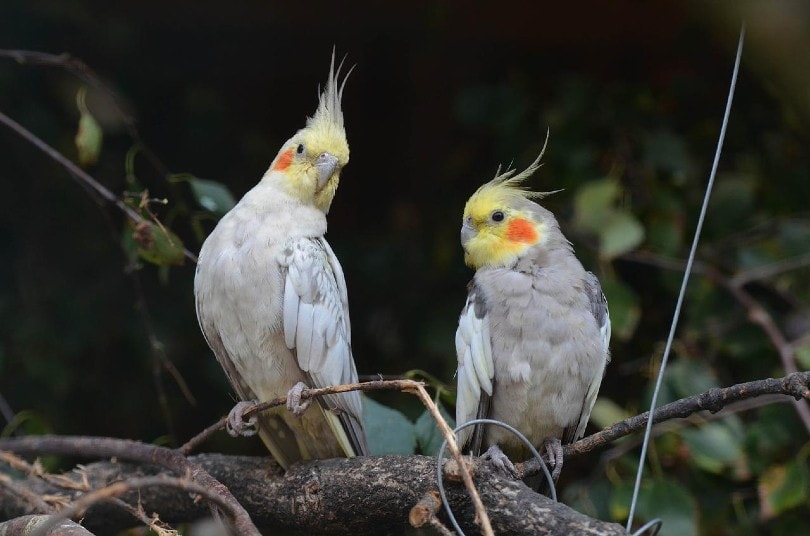
Suitable For:
First-time and experienced bird owners looking for a friendly, intelligent bird, and that can give their new pet plenty of time out of the cage and regular handling.
- Tolerates careful handling
- Can live with other docile bird species
- Can be trained
- Can be prone to infections
Lovebird Overview
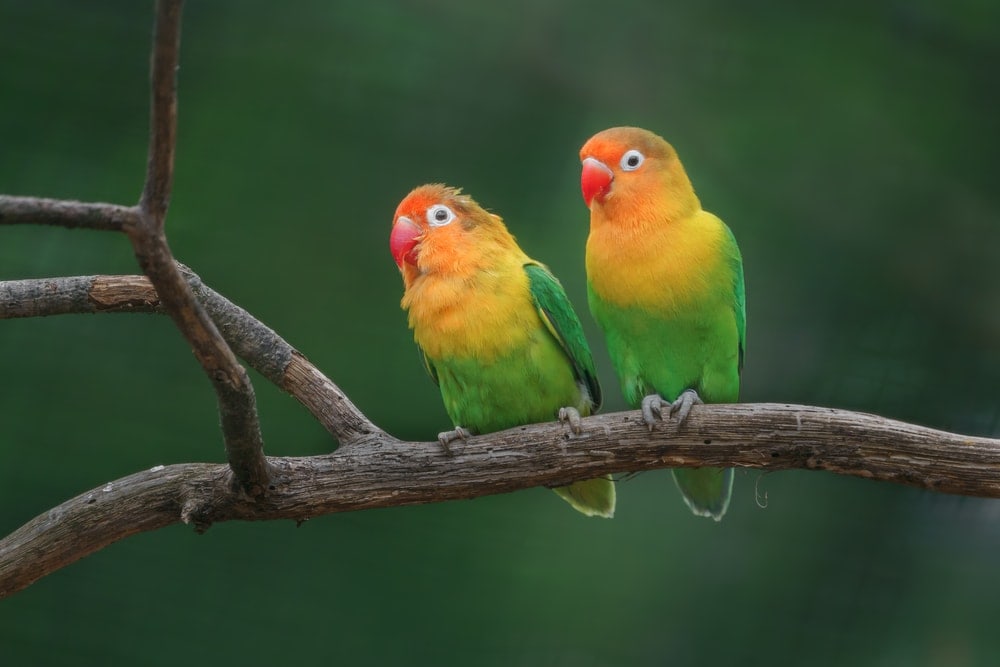
The Lovebird is a popular pet bird species that is even smaller than the Cockatiel. They are beautiful-looking birds that come in a great variety of colors and hues. They originate from parts of Africa and Madagascar and they get their name because the species will bond closely to another Lovebird of the opposite gender and will usually mate for life. Lovebirds need this closeness, which means that if you keep one Lovebird (which is not recommended), you will need to provide company for your little bird.
Personality / Character
Lovebirds are active and energetic little birds that are also inquisitive and like to be involved in whatever is going on. As long as you handle them regularly, they should be quite comfortable being let out of the cage and they can be trained to sit on your hand. If you keep a single Lovebird, this is more likely because this is one species that craves attention and affection more than any other.
Training and Handling
The Lovebird can tolerate being handled, but it does require regular handling and ideally from a young age. It is an inquisitive bird so will enjoy spending time out of the cage. The Lovebird cannot speak but can be trained to follow some basic commands, although it does also have a mind of its own. Solitary Lovebirds are more likely to take to training, otherwise one of a bonded pair is more likely to give its attention to its partner.
Health & Care
Like the Cockatiel, the Lovebird does need to have its claws trimmed and it can benefit from having a spray bath every now and then. It needs regular time out of its cage to ensure that it gets enough exercise and stimulation.
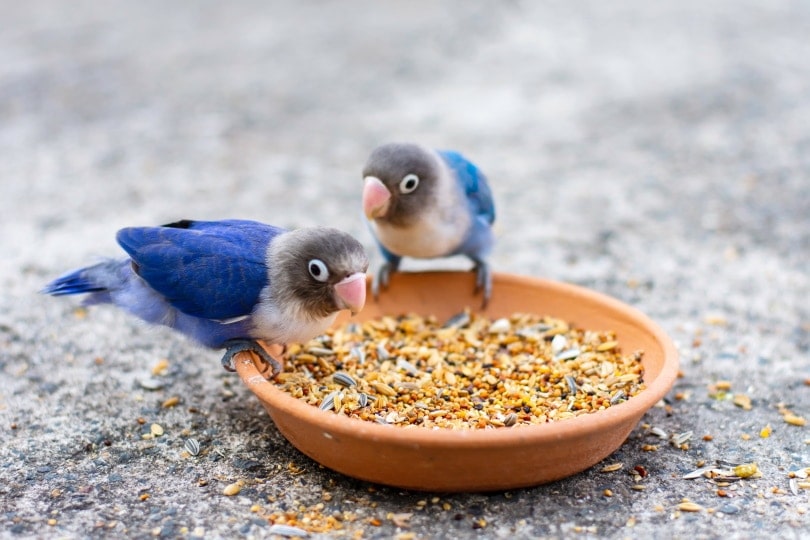
Suitable For:
First-time and experienced owners looking for a pretty bird that won’t talk but can take to handling with regular training.
- A great variety of colors is available
- Inquisitive, fun little bird
- Can be handled
- Can’t be kept in an aviary with other birds
Best Breed For Existing Aviaries
Most, but not all, Lovebirds benefit from being kept as a pair but this species can be aggressive which means that it shouldn’t be kept in an aviary with other birds. Lovebirds will bully more docile breeds, including Cockatiels. On the other hand, Cockatiels can be kept in an aviary with other species, as long as they are not aggressive birds that will pick on the Cockatiels.
Handling
Both species can be handled, but it is best to start when the birds are young and continue with regular handling. In all cases, owners need to handle the birds carefully and be especially careful not to put too much pressure on the chest area because this can restrict breathing. Children should always be supervised when handling birds, and this is true of both these species of small parrots.
Care Requirements
Birds like Cockatiels and Lovebirds thrive when they are given regular time out of the cage. It lets them spread their wings, and get some exercise, and it also provides mental stimulation. Leaving them locked in a cage all day can cause boredom and depression. Always make sure doors and windows are closed before letting your bird out, and use food or other treats if you are struggling to get them back into the cage. Both species need help to clip their claws and you do need to feed them an appropriate diet. Otherwise, these two species are considered low maintenance and relatively easy species to care for.
Which Breed Is Right for You?
Both these species of parrots are considered good for beginner to intermediate owners because they have fairly easy requirements, can take to handling, and don’t take up that much space compared to larger parrots. However, they do need time out of the cage, benefit from regular handling, and need toys and other items that will provide mental stimulation as well as physical. It is likely to come down to whether you want to keep the birds with other species, in which case the Cockatiel is the best option, or if you want a more colorful bird, the Lovebird comes in a gamut of colors.
Related Read:
- Parrotlet vs Cockatiel: The Differences (With Pictures)
- Cockatiel vs. Parakeet: The Differences (With Pictures)
Featured Image Credit: (L) Alena Gerasimova, Shutterstock | (R) David Herraez Calzada, Shutterstock


